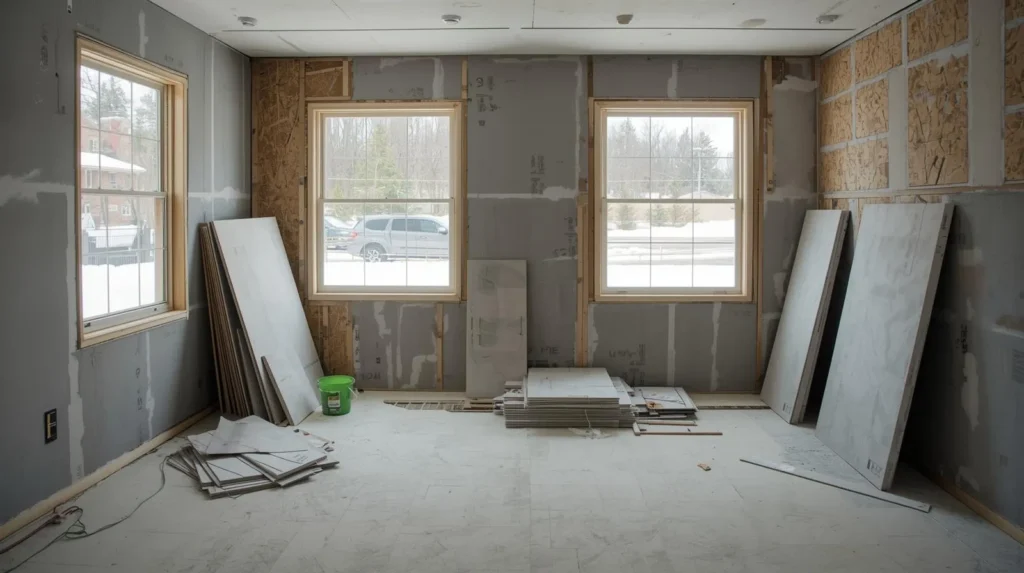Choosing the right drywall thickness for wall construction is crucial for both structural integrity and aesthetic appeal. Many homeowners and builders overlook this detail, but the correct drywall thickness can affect everything from sound insulation to fire resistance. Whether you are remodeling a bedroom or building a new residential space, understanding how to pick the ideal drywall can save time, money, and frustration.
Understanding Drywall Thickness Options
Drywall comes in several thicknesses, typically ranging from 1/4 inch to 5/8 inch. Each thickness serves a distinct purpose depending on wall type, room function, and building codes. For example, thinner drywall panels, like 1/4 inch, are generally used for curved walls or to overlay existing walls. Meanwhile, 1/2 inch sheets are standard for most residential walls, balancing strength and ease of installation. Heavier 5/8 inch panels provide better soundproofing and fire resistance, making them ideal for ceilings or shared walls in multi-unit buildings.
Common Thicknesses and Their Uses
- 1/4 inch: Flexible for curves and lightweight applications
- 3/8 inch: Often used for layering over existing surfaces
- 1/2 inch: Standard for most interior walls
- 5/8 inch: Excellent for sound reduction and ceilings
Choosing the right drywall thickness for wall projects depends on both practical needs and local building requirements.
Factors Affecting Drywall Selection
When determining drywall thickness for wall use, several factors should be considered. Structural demands, moisture levels, and sound insulation are key aspects that influence your choice. For instance, bathrooms and kitchens often require moisture-resistant panels, while bedrooms near busy streets benefit from thicker drywall to reduce noise.
Structural Considerations
Walls that support heavier fixtures or cabinets might need thicker sheets to prevent sagging. In addition, ceilings often require 5/8 inch drywall to resist bending over long spans. Considering the load a wall may carry ensures long-lasting stability and prevents future issues.
Moisture and Sound Factors
In areas prone to humidity, such as bathrooms or laundry rooms, moisture-resistant drywall prevents swelling and warping. Meanwhile, thicker panels improve soundproofing, making them ideal for home offices, nurseries, or entertainment rooms. Choosing drywall with the right density and thickness enhances comfort and durability in everyday living spaces.
Installation Tips for Various Wall Types
Knowing the ideal drywall thickness for wall installation is just part of the equation. Proper handling and placement during installation are equally important to achieve a smooth, lasting surface.
Standard Walls
For typical residential walls, 1/2 inch drywall is both cost-effective and durable. Installing panels vertically or horizontally depends on wall height and stud spacing. Vertical placement is easier in standard 8-foot walls, while horizontal sheets minimize seams in taller walls.
Ceilings and Special Applications
Ceilings benefit from thicker drywall, usually 5/8 inch, to prevent sagging. In rooms where sound insulation matters, adding a layer of 5/8 inch drywall or using sound-dampening boards between studs can make a noticeable difference. Special curves or decorative features may require 1/4 inch flexible drywall to achieve smooth bends without cracking.
Choosing the Right Drywall for Residential Projects
Selecting drywall for a residential space is more than picking a sheet off the shelf. Homeowners must weigh durability, cost, and aesthetics when choosing the right thickness.
Budget Considerations
While thicker drywall panels offer better performance, they are heavier and slightly more expensive. If budget is a concern, 1/2 inch sheets provide an excellent balance of cost and functionality for most walls. Prioritizing thicker drywall only for high-impact areas like shared walls, ceilings, or sound-sensitive rooms can save money without compromising quality.
Enhancing Comfort and Style
Beyond structure, drywall thickness can affect how rooms feel. Thicker panels can muffle street noise or make large open areas feel cozier. Installing drywall with appropriate thickness also ensures smoother finishes for paint or wallpaper, creating a polished look that adds value to your home.
Maintenance and Longevity Tips
Once the right drywall thickness for wall use is chosen and installed, proper care ensures it stays in good condition. While drywall is low-maintenance, some simple practices help maintain durability and appearance.
- Avoid hanging overly heavy items without using anchors or studs
- Keep moisture levels in check in kitchens and bathrooms
- Use touch-up paint or filler for minor surface dents or scratches
- Regularly inspect high-traffic areas for signs of wear
Consistent attention can extend the life of your drywall and maintain the look and comfort of your home for years.

FAQ About Drywall Thickness for Wall Use
What thickness drywall is best for standard interior walls?
1/2 inch drywall is most commonly used for standard residential walls, providing a balance of strength and ease of installation.
Can I use 1/4 inch drywall on curved walls?
Yes, 1/4 inch drywall is flexible enough for curved surfaces and decorative features.
Which drywall thickness is ideal for ceilings?
5/8 inch drywall is preferred for ceilings to prevent sagging, especially for spans longer than 4 feet.
Does thicker drywall improve sound insulation?
Absolutely. Thicker panels, especially 5/8 inch, help reduce noise between rooms, making homes quieter and more comfortable.
Should moisture-resistant drywall be thicker than standard sheets?
Moisture-resistant drywall comes in similar thicknesses as standard panels, typically 1/2 or 5/8 inch. The key is the moisture-resistant coating, not the thickness.
Conclusion
Determining the right drywall thickness for wall construction involves understanding the needs of your space, from structural support to soundproofing and moisture protection. By considering factors like wall type, room function, and building codes, you can select panels that enhance both durability and comfort. For residential projects, 1/2 inch drywall works for most walls, 5/8 inch excels in ceilings and shared walls, and 1/4 inch is ideal for curves and specialty features. Proper installation and maintenance extend the lifespan and appearance of your walls, making your home both functional and inviting. For professional guidance and high-quality materials tailored to residential spaces, AGP Drywall for Residential areas offers expertise to help every project succeed.


 Blog
Blog